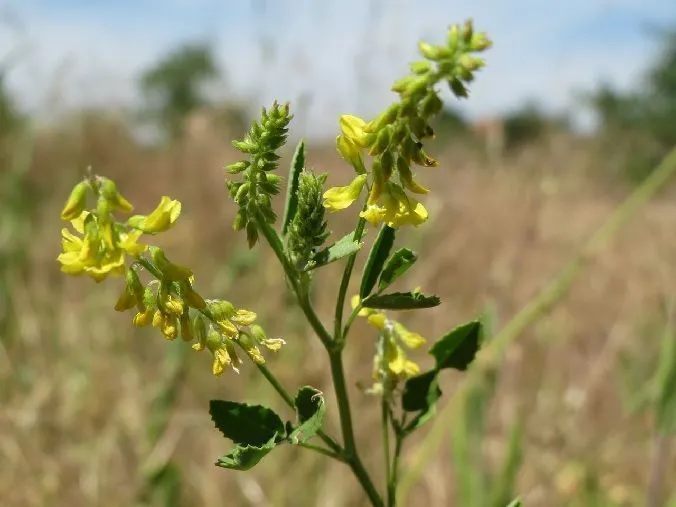We can meet melilotus officinalis in some other ways, such as yellow-smelling clover , yellow melilote, sweet clover or scent clover. This plant has, today, a lot of potential applied to the medicine of the human being. It is currently cultivated as a fodder plant and to improve poor soils, since it belongs to the family of legumes (with great potential to fix atmospheric nitrogen in symbiosis with microorganisms).
Table of Contents
Characteristics of melilotus officinalis
In this part we give you the idea of the size and characteristics of this plant, so that for those interested in planting and cultivating it, for medicinal purposes, they can know it and adapt it to their land or garden space.
Melilotus officinalis is a grass or fodder type plant. It does not reach a great height but it does occupy large areas of land. As an ornamental it has no appreciation, because its flowers are small and yellow.
However, it is interesting to use it to improve the soil. On the one hand, it is a legume that provides nitrogen to the soil when it interacts with fixing microorganisms. On the other hand, its pivoting root improves the texture of the soil and the balance between the liquid and gaseous part of the earth. Regarding the former, its potential as a nitrogen fixator has been investigated for years, and it reached levels that could be excessive in terms of nitrates (Kingsbury, 1964). It all depends on the growth of the plant, its root development and the way it is grown.
Conditions of its cultivation
Although its cultivation is also not interesting when we see it from the medicinal point of view (but if fodder, for animal feed), we give some cultivation tips.
Melilotus officinalis it adapts to medium quality terrains (better those that are sandy), with good light disposition (meadows and meadows, for example) and with good drainage. It prefers those soils with basic or alkaline pH, and is able to withstand high levels of salinity.
As for the dosage of water and irrigation, it is able to withstand drought and dry conditions in the soil quite well. It also adapts quite well to periods of scarcity of rain, given that it has a powerful root system. This allows it to adapt quite well to all environments (it is native to Europe and Asia), even becoming an invasive plant, given its rapid growth.

The properties of coumarin, a compound present in melilotus officinalis
A component of great importance present in the yellow-smelling clover and that has different applications is the coumarin. It is an organic chemical compound considered as a secondary metabolite of the plant, and which has anticoagulant properties. Of course, this makes us think of the title of this article, where we mentioned the improvement of blood circulation with the preparations of the medicinal plant melilotus officinalis. Although at the moment, we are not going to anticipate events 🙂
Medical Uses of Coumarin
Apart from the anticoagulant potential of this metabolite, they have also been investigated to treat diseases in other fields of medicine. We can see the following cases:
- The activity of coumarin and its derivatives has antitumor potential.
- Has antiarrhythmic effect
- Antiinflammatory
- Antiseptic and analgesic
- Reduces blood pressure
- It has been used for asthma treatments (Liu, H., 2011)
All these effects are contrasted and, in fact, coumarin is present in some drugs that are marketed for the treatment of some of these pathologies.
However, not everything was going to be good in the Lord’s vineyard. Coumarin, depending on the dose, has a toxic effect on liver and fronds. The lethal dose (LD50) has been set at an amount of 275 mg/kg.
The anti-inflammatory effects of this medicinal plant can be combined with others of similar action, such as Lavandin, to create an oil for application on the skin.
Melilotus officinalis as a medicinal plant
When grown for medicinal purposes, the entire plant is usually plucked, leaving it to dry in sunny, airy environments. From it is used floral branches and even some tender stems. We will notice in its drying as it gives off an intense aroma and in flavor it is spicy and bitter.
Basically, the importance of this crop as a medicinal plant is based on its composition in coumarin and derivatives. The properties of this compound have been mentioned before, when it was synthesized and added to medicines.
At lower levels, it has the same effects, although we will always consider the dose limit that can become toxic for us.
Do not be afraid of the issue of toxicity, because even water becomes toxic when ingested in significant quantities. Dosage is the best weapon for any eating habit.
